- Home
- Introduction, Update Information, Links
- The Super Seventies "Classic 500"
- Readers' Favorite Seventies Albums
- Seventies Single Spotlight
- The Top 100 Seventies Singles
- Favorite Seventies Artists In The News
- Seventies Almanac - Year By Year
- Seventies Singles - Month By Month
- Seventies Albums - Month By Month
- Seventies Daily Music Chronicle
- Seventies Superstars In Their Own Words
- The Super Seventies Archives
- Seventies Trivia Quizzes & Games
- Seventies MIDI Jukebox
- The Super Seventies Bookstore
- The Super Seventies Photo Gallery
- Seventies' Greatest Album Covers
- Popular Seventies Movies & TV
- Seventies Celebrity Portrait Gallery
- Seventies Lyrics Hit Parade
- Top Seventies Artist Music Videos
- Seventies Usenet Music Forums
- Seventies Smiley Calendar
- EXTRA!
- Superseventies.com Facebook Page
- Superseventies.com Reddit Discussions
- The Super Seventies Blog
- Tweet The Seventies
- RockSite InfoBank
- Beatlefan Site
- Thanks For Your Support! / Top Sellers
- Search The Rock Site/ The Web
![]()
As the beloved sitcom marks its 50th anniversary, star Alan
Alda talks about its mix of wartime drama and humor.
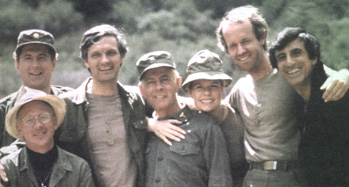 By Mara Reinstein
in Parade
By Mara Reinstein
in Parade
![]() istory lessons typically aren't entertaining, let alone funny. But how about this one? A surgeon named H. Richard Hornberger wrote the 1968 book MASH: A Novel About Three Army Doctors
(under the pseudonym Richard Hooker), based on his experiences in the Korean War. Director Robert Altman adapted it into a classic 1970 movie. Then, on September 17, 1972, M*A*S*H
premiered on TV, in between Anna and the King
and The Sandy Duncan Show
on CBS. With an eclectic ensemble led by Alan Alda, Loretta Swit and Jamie Farr, it focused on the doctors and staff stationed at the 4077th Mobile Army Surgical Hospital in the early 1950s who resorted to jocular hijinks and petty rivalries to get through the traumas of war.
istory lessons typically aren't entertaining, let alone funny. But how about this one? A surgeon named H. Richard Hornberger wrote the 1968 book MASH: A Novel About Three Army Doctors
(under the pseudonym Richard Hooker), based on his experiences in the Korean War. Director Robert Altman adapted it into a classic 1970 movie. Then, on September 17, 1972, M*A*S*H
premiered on TV, in between Anna and the King
and The Sandy Duncan Show
on CBS. With an eclectic ensemble led by Alan Alda, Loretta Swit and Jamie Farr, it focused on the doctors and staff stationed at the 4077th Mobile Army Surgical Hospital in the early 1950s who resorted to jocular hijinks and petty rivalries to get through the traumas of war.
The show didn't initially catch on with viewers, but it was an acclaimed critical success from the start, winning its first four Emmys -- including one for Outstanding Comedy Series -- in 1974. (In all, it received 109 Emmy nominations and 14 wins.)
"It was a brilliant mash-up of comedy and drama with a wonderful cast and great characters," says Television Academy senior vice president of awards John Leverence. "But it also included this emotional detachment from these real-life horrors that was, and still is, part of American culture." Though the Korean War lasted three years, one month and two days, M*A*S*H aired for 11 seasons, and its 1983 finale remains the most-watched TV series episode in history. In honor of its 50th anniversary, we give this prime-time classic a proper salute with an exclusive interview with Alda and ten things you probably didn't know about the beloved show.
HAWKEYE VIEW
 Native New Yorker Alan Alda served in the military as a gunnery officer during the Korean War. As irreverent surgeon Capt. Benjamin Franklin "Hawkeye" Pierce on M*A*S*H,
he was the heart and soul of the series -- and racked up 25 Emmy nominations for acting, writing and directing in the process. Alda, 86, has since become a prolific actor ( The West Wing, Ray Donovan
) and author, and he currently hosts the podcast Clear+Vivid.
(He's also been married to his wife, Arlene, since 1957!)
Native New Yorker Alan Alda served in the military as a gunnery officer during the Korean War. As irreverent surgeon Capt. Benjamin Franklin "Hawkeye" Pierce on M*A*S*H,
he was the heart and soul of the series -- and racked up 25 Emmy nominations for acting, writing and directing in the process. Alda, 86, has since become a prolific actor ( The West Wing, Ray Donovan
) and author, and he currently hosts the podcast Clear+Vivid.
(He's also been married to his wife, Arlene, since 1957!)
How did you get to M*A*S*H ? I was shooting a movie [ The Glass House ] in Utah State Prison, and one day a script came in for me at my hotel. It was written by Larry Gelbart and it was the best comedy writing I'd ever seen in a half-hour script. It certainly brightened up my day in cell block 9. Right away, I knew I wanted to play in it.
When did you realize the show had become a major hit? I don't know if we ever really realized how successful the show was. We started out at the bottom of the ratings, and we just got used to concentrating on the work every day. For most of the first year, I'd proudly say, "We're in the Top 72!"
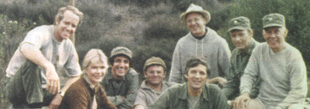 The cast -- and not just the characters -- always seemed to genuinely like each other. True?
I think we all knew that to play these characters, we had to have the closeness of people who spent their lives eating together, tending wounded together and sleeping, if not together, then at least nearby. So we worked at it. For the first season, every Friday night we'd stay late and eat pizza and drink beer and end many Fridays in a circle airing our complaints to one another. During the shooting day, we'd hang out together in our circle of chairs and tell stories and play games and rib each other. We'd make real contact that was open and free so that when we'd be called to the set, the connection was still happening underneath the dialogue of the scene. We're all still in touch by email, and before COVID, we'd try to get together for dinner at least once a year.
The cast -- and not just the characters -- always seemed to genuinely like each other. True?
I think we all knew that to play these characters, we had to have the closeness of people who spent their lives eating together, tending wounded together and sleeping, if not together, then at least nearby. So we worked at it. For the first season, every Friday night we'd stay late and eat pizza and drink beer and end many Fridays in a circle airing our complaints to one another. During the shooting day, we'd hang out together in our circle of chairs and tell stories and play games and rib each other. We'd make real contact that was open and free so that when we'd be called to the set, the connection was still happening underneath the dialogue of the scene. We're all still in touch by email, and before COVID, we'd try to get together for dinner at least once a year.
What were you doing when the last episode aired? Loretta and I were in a car on the way to a restaurant to celebrate with the rest of the cast, and we realized with a jolt that the streets were empty. Almost no cars. Then it hit us that people were home watching or last show.
M*A*S*H mixed humor with the realities of war. How did you approach that tricky combination? I think a lot of what attracted people to the whole series was that even though it was mainly a comedy, we never tried to forget that real people had lived and suffered through stories like the ones we were telling. We wanted to honor that as much as we could.
How did the show change your life? I became a better actor, better writer and learned how to direct. But more than that, it thrust all of us into something that was more important than we were. I think we all feel gratitude for that and feel lucky that we got to experience it together. But 50 years is a long time ago, it almost feels like it happened to someone else. It's nice, though, that he still lets me live in his house.
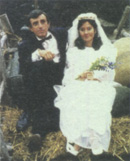 1. YES TO THE DRESS
1. YES TO THE DRESS
Corporal (later Major) Maxwell Q. Klinger (played by Jamie Farr, now 88) could sometimes be seen in a wedding dress, including when he married Laverne Esposito. When he remarried in the series finale, his bride, Soon-Lee (Rosalind Chao), wore it. He gave "Hot Lips" another wedding gown in his collection when she tied the knot with Lt. Col. Donald Penobscott (Mike Henry). Farr had actually served in the Army during the Korean War.
2. NO BOOTS ON THE GROUND Most of the time, the cast went without an important part of the Army uniform -- thick combat boots. The reason? The loud clunking footsteps would ruin the on-set audio. Instead, the cast donned sneakers and cameramen made a point to shoot the characters from the waist up.
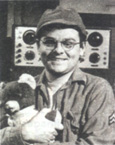 3. RADAR'S BELOVED TEDDY
3. RADAR'S BELOVED TEDDY
Corporal Walter "Radar" O'Reilly's stuffed bear -- which Hawkeye eventually placed in a time capsule -- was meant to symbolize all the boys who came overseas and then left as men. But when the show ended, the stuffed animal was lost. That is, until in turned up at an auction in 2005. It sold to a medical student for $11,800. The student later sold it to Radar actor Gary Burghoff, now 79, who sold it at auction for $14,307.50 in 2014.
4. QUITE THE GUEST LIST Many future stars got head starts in Hollywood by appearing on the show, usually as patients. A young Patrick Swayze portrayed an injured soldier with leukemia. Seasoned actor Leslie Nielsen was a colonel. John Ritter, Laurence Fishburne, Rita Wilson, George Wendt, Shelley Long, Blythe Danner and Teri Garr guest-starred. And a teen Ron Howard played an underage soldier posing as his older brother to impress a girl.
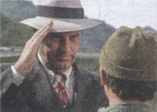 5. A SAD TWIST
5. A SAD TWIST
When McLean Stevenson, who played Lt. Col. Henry Blake, wanted out of the show after three seasons, it led to one of its most memorable episodes. In "Abyssinia, Henry" (season three, episode 24), not only did viewers say goodbye to the honorably discharged Lieutenant Colonel, they learned in the final scene that his plane had been shot down with no survivors. (Among the cast, only Alda knew about the twist.) "It felt like you were marching in a parade and then hit a brick wall," Leverence says of the episode. (Stevenson died in 1996.)
6. MORE THAN JUST ACTORS Two-time Emmy winner Loretta Swit (head nurse Maj. Margaret "Hot Lips" Houlihan) has had only one acting credit since 1998, but offscreen Swit, 84, has written books on needlepoint and is a longtime animal activist. And fan-favorite Burghoff, who originated the character of kind-hearted company clerk Radar in the movie and played him in eight seasons of the series, is an inventor -- he owns patents for a special fishing pole and a toilet-seat-lifting handle!
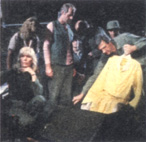 7. THAT'S NOT KOREA
7. THAT'S NOT KOREA
California's Fox Ranch (later Malibu Creek State Park) stood in for Korea. That's where characters in the penultimate episode, "As Time Goes By," buried a time capsule. The cast buried one of their own that they hoped would be discovered many years later. Just two months later after the episode aired, a construction worker found it.
 8. THE GRAND FINALE
8. THE GRAND FINALE
M*A*S*H
provided viewers with 251 witty and warm episodes over its 11 seasons. (It's now streaming on Hulu, and can also be seen on TV Land and MeTV.) A favorite was "Goodbye, Farewell and Amen" (season 11, episode 16). More than 120 million viewers tuned in to see the finale (directed and co-written by Alda), in which the war ends and the staff goes their separate ways. "It had so much substance," Leverence says. "And it had a really strong emotional component, which was necessary."
9. BREAKING TABOOS
In addition to its frank depictions of war, M*A*S*H
also broke long running taboos against vulgarity and nudity on network television. In the eighth season, Hawkeye Pierce plainly calls a North Korean officer who had kidnapped one of his wounded soldiers who had found his way under Hawkeye's care a "son of a bitch." Another taboo was broken when Radar O'Reilly was shown, albeit very briefly, in a nude scene.
10. KLINGER'S FAVES
As part of a recent 50th anniversary M*A*S*H
celebration on MeTV, Jamie Farr -- aka Maxwell Q. Klinger, the corporal who practiced cross-dressing to finagle a Section 8 discharge -- picked his Top 10 episodes for a five-night event. "The Best by Farr," started, appropriately, with Klinger's debut in season 1, episode 4, "Chief Surgeon Who?" Recalls the actor: "I was out of work, and this gave me my job and a comeback. It was a one-day job, got $250." Thanks to the character's popularity (or was it his fashion savvy?) Farr returned again and again. Later in the week, viewers also got two of Klinger's most magnificent looks: a salute-worthy Statue of Liberty in 1975's "Big Mac" and a tutti-frutti-hatted Carmen Miranda in 1975's "Abyssinia Henry."
![]()
The singing superstar on the stories behind losing her voice, her new
book, celebrating her Mexican heritage, and the stories behind her hits.
By Jim Farber in Parade
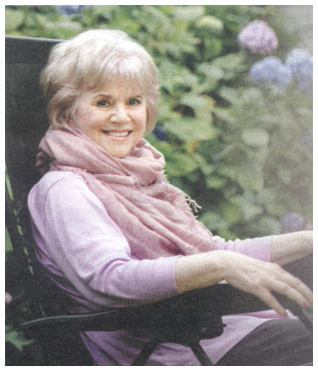
![]() lmost a decade ago, Linda Ronstadt was diagnosed with Parkinson's disease. In 2019, her condition was rediagnosed as progressive supranuclear palsy, a degenerative, Parkinson's-like disease for which there is no known cure. It robbed her of her distinctive soprano musical voice, ending a career that had made her one of the most popular and accomplished vocalists of her generation. A recipient of 11 Grammy Awards, plus the Recording Academy's Lifetime Achievement Award in 2016, she's also in the Rock and Roll Hall of Fame and the recipient of a Kennedy Center Honor.
lmost a decade ago, Linda Ronstadt was diagnosed with Parkinson's disease. In 2019, her condition was rediagnosed as progressive supranuclear palsy, a degenerative, Parkinson's-like disease for which there is no known cure. It robbed her of her distinctive soprano musical voice, ending a career that had made her one of the most popular and accomplished vocalists of her generation. A recipient of 11 Grammy Awards, plus the Recording Academy's Lifetime Achievement Award in 2016, she's also in the Rock and Roll Hall of Fame and the recipient of a Kennedy Center Honor.
Today, music is always with her -- and within her. "I can still sing in my mind," she says. "Sometimes I have to look up the words, because I forget the lyrics. But then I'll sing a song in my head all the way through, like a hummingbird."
At the zenith of her superstardom in the 1970s and into the '80s, Ronstadt was the pre-internet pop-culture darling. And not just for her hit songs. Her romances -- with California governor Jerry Brown, with filmmaker George Lucas, with comedian Albert Brooks -- also made headlines. She never married, and she successfully kept her two children, Mary and Carlos, both adopted in the 1990s, out of the spotlight.
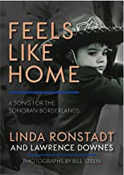
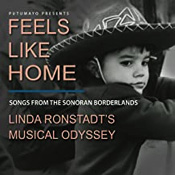 Her career path was a wide-ranging odyssey across various musical forms and formats -- pop, rock, punk, country, folk, opera, classical, Spanish and Latin -- all grounded in her passion for music. These days, she says, "I listen mostly to opera. I love opera more than anything. I can listen to music really passionately now."
Her career path was a wide-ranging odyssey across various musical forms and formats -- pop, rock, punk, country, folk, opera, classical, Spanish and Latin -- all grounded in her passion for music. These days, she says, "I listen mostly to opera. I love opera more than anything. I can listen to music really passionately now."
Another passion, especially in recent years, has been doubling down to make clear to the world who she truly is. Born and raised in Tuscon, Ariz., she was steeped in the music and culture of her father's side of the family, whose roots were deep in Mexico. It frustrates her that, throughout her four-decade career, the media has seldom acknowledged her Southwestern heritage, even when she emphasized it by recording albums like Canciones de Mi Padre, her 1987 collection of traditional Mexican songs that became the biggest-selling non-English-language album in U.S. history.
To help correct that, two years ago she took part in a documentary, Linda and the Mockingbirds, which followed her on an emotional trip she took to the rural Mexican town of Banámichi, where her grandfather grew up. Now, Ronstadt, 74, is releasing the book she wrote with journalist Lawrence Downes, Feels Like Home: A Song for the Sonoran Borderlands (Oct. 4), which illuminates the culture, food and natural wonders of the Sonoran Desert, which stretches from her Arizona childhood home through a large swath of northern Mexico. A companion album of songs Ronstadt has admired, sung or recorded over the years, Feels Like Home: Songs From the Sonoran Borderlands -- Linda Ronstadt's Musical Odyssey , will be released Oct. 7.
We spoke with Ronstadt from her San Francisco home.
Home Is Where The Tortillas Are
How did the Sonoran region where you grew up shape you? I grew up in a certain way, in a certain place. There weren't trees. It wasn't green everywhere and I got used to that. Even now, I don't like to live where there are too many trees. I want to be able to see.
What do you hope readers learn? The desert isn't a wasteland. It's rich and bountiful, but you have to treat it carefully.
How did it feel to revisit your family's past? It brought happy feelings, because we would always go to Mexico together. My dad knew everybody along the way. It's just a magical place.
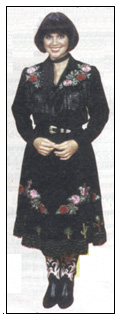
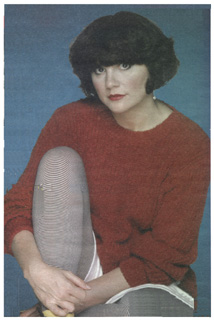 You have such a love of food, but you write in your book that you never learned to cook?
Well, I was living in a hotel for decades. Being on the road is not conducive to cooking. I was better at needlework, because I could take it with me on the road.
You have such a love of food, but you write in your book that you never learned to cook?
Well, I was living in a hotel for decades. Being on the road is not conducive to cooking. I was better at needlework, because I could take it with me on the road.
Your book includes recipes from the area. What's special about that food? They didn't have refrigeration, so the food had to be preserved by drying it or pickling it. They eat a lot of dried meat, dried fruit and pickled vegetables. But there's very rich soil, so the vegetables taste better. It's the breadbasket of Mexico.
Lately you've been emphasizing your heritage more than ever. Why? Because I demand it. I used to give interviews when I was starting out, and they would say, "Where are you from? And I would say, "I'm Mexican and German," and they would say, "Oh, are you Spanish?" I would say, "No...Mexican." That's like mixing up Americans and Australians. It's a totally different culture."
Were you surprised that your first album of Mexican songs was an enormous hit? I didn't give it a thought. I just thought, I'm going to record these songs and I don't care what they do with it. I felt I'd earned the right to do a "vanity project" [laughs]. I grew up singing that music, but those songs are hard to sing. I had to learn how to sing them on a professional level. That the album turned out to be a hit allowed me to do another [Mexican album], and it was better because I learned to sing those kinds of songs better.
What are your favorite Mexican songs? "Mi Ranchito" [my little farm], about the ranch where I grew up. "El Sueño" [the dream]. I recorded with my brothers -- my older and younger brother. "El Fango" is utterly mysterious and fascinating to me. It's a straight waltz, beautiful poetry.
The book is filled with song, whether you're singing with your siblings or sharing lyrics. Was that emotional after losing your voice to Parkinson's? That was really hard because there's something that family does that you can't quite duplicate. I have great memories of singing with Emmylou Harris and Aaron Neville, but family is something else.
You sang with such power that it was almost unthinkable that you would ever lose that ability. But you seem to have been very accepting of that loss and of your disease. Well, I don't have a choice. If I had a choice, then I might be pissed off. I try not to live in the future. I live in the present. I mean, we're all going to die of something, we just don't know what it is. I don't know what it is. Yes, I have a progressive disease, but I might get hit by a bus next week. I've been lucky. I have had a lot of really good help. My daughter is very helpful, so I'm well taken care of.
You sang in so many styles over your long career. What, for you, ties it all together? Singing at home with my family is the source of it all. If I hadn't heard a style of music by the time I was 10, I didn't try to do it, because I couldn't do it authentically. I wouldn't try to sing the blues, for instance. Bonnie Raitt grew up playing blues, so she can do it. Luckily, my parents had a variety of tastes. They gave [me] Gilbert and Sullivan. They gave Sinatra and Hank Williams. And my grandparents loved opera. My music comes from everything I heard in our living room growing up.
The Stories Behind The Songs
"DIFFERENT DRUM" 1967
When you changed the genders in the song, did you mean to make a feminist statement about a woman who won't be tied down?
No! [Laughs] I don't think I'd ever heard of feminism at that point! I was too naïve. I thought feminism was not using makeup.
But did the lyric reflect your independent attitude at the time? Absolutely, I still feel that way. I can't be pinned down to what carpet color to use. I would change it every week!
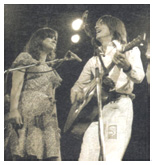 "ROCK ME ON THE WATER" 1972
"ROCK ME ON THE WATER" 1972
What drew you to record a song by Jackson Browne?
I first met him when he was 16 and I was 17. He was writing really good songs even then. There were really good songwriters in L.A., and he was clearly one of the best. I met him when a friend of ours said he'd been fun to talk to. I heard an acetate of "Rock Me on the Water" from the publishing company he had signed with, and I was just blown away. That first album he did [which featured his version of "Rock Me"] was perfect. He still makes good records.
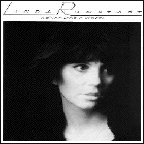 "YOU'RE NO GOOD" 1974
"YOU'RE NO GOOD" 1974
I did that song as an afterthought. We just needed a fast song to perform in the show. It can't be all ballads or it gets boring. So I had to learn an up-tempo song fast and I had just heard that one on the radio.
"POOR POOR PITIFUL ME" 1977
What appealed to you about Warren Zevon's songs?
His songs weren't easy for me to sing, but he was a true original. He had such unusual ideas in his lyrics. He had a grim humor.
"BLUE BAYOU" 1977
Was the operatic melody of Roy Orbison's song the reason you recorded it?
I was at a jam session one late night in Malibu, with Jackson and J.D. Souther, and J.D. sang it for me. I thought, I'm going to record that.
Roy Orbison sings in my range and this had an excellent melody. In some melodies, there's not very much for my voice to get hold of, but this had a melody that soared!
"OOH BABY BABY" 1978
What led you to record this Motown hit?
"Ooh Baby Baby" was my idolizing Smokey Robinson. I love his voice and his songwriting. I love him! He's so charming and sincere and the song fit me because he's a soprano.
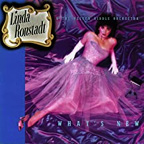 WHAT'S NEW
1983
WHAT'S NEW
1983
What was it like to work with the orchestral arranger Nelson Riddle on this album of standards?
It was like swimming in cream. He's just a brilliant arranger. He can put strings on a song without making it sound syrupy. I really learned those songs by polishing up my voice singing on Broadway [in "The Pirates of Penzance"]. Standards require what they call "the mix," which combines your head voice and your chest voice. And the songs are so amazing. When you think of what Americans have contributed to the culture of the world at large over the last 150 years, it's been the popular song. And those are the best popular songs.
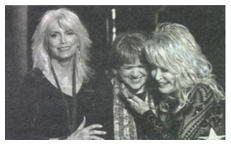 "THOSE MEMORIES OF YOU" 1987
"THOSE MEMORIES OF YOU" 1987
How did your group with Dolly Parton and Emmylou Harris, known a the Trio, come about?
It was an accident. I went over to Emmylou's house one day and Dolly was there, so we sat down and started singing a Carter Family song, and we found that the sound we had was different. So we said, "Let's do an album together." Emmylou came up with the material. I came in with the harmony arrangements. We're all natural harmony singers. We didn't have to fight over not getting to sing a lead. We just went with whoever sang the lead best on that song.
"I NEVER WILL MARRY" 1977 Dolly Parton and I both love this song and recorded it together. According to Ronstadt family rules, this was my sister's song, because she was the first of us to sing it. But Suzy married three times, so it became mine.
"DON'T KNOW MUCH" 1989
Why do you think you paired so well with Aaron Neville on this No. 2 song?
He sings up in my key. His style of singing comes from French baroque opera. The Creoles down in Louisiana were people of color who had their own sound. It was a very wealthy and cultured society. They sent their children to school in France and they'd come back with that style of singing. You don't belt it, like the Italians do. You sing it as a light falsetto, and it persists to this day. It only happens there. Aaron developed his own distinct sound from it.
![]() Reader's Comments
Reader's Comments
No comments so far, be the first to comment .
![]() Best of EXTRA!
| EXTRA!
| Main Page
| Seventies Single Spotlight
| Search The RockSite/The Web
Best of EXTRA!
| EXTRA!
| Main Page
| Seventies Single Spotlight
| Search The RockSite/The Web


